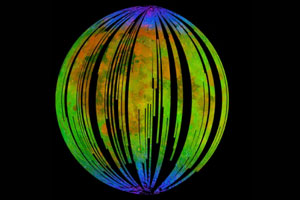 Map of Moon water; blue indicates higher concentrations of detected water molecules. Credit: NASA/Moon Mineralogy Mapper instrument.Here it comes! A veritable tidal wave of discovery on Earth's Moon….
Map of Moon water; blue indicates higher concentrations of detected water molecules. Credit: NASA/Moon Mineralogy Mapper instrument.Here it comes! A veritable tidal wave of discovery on Earth's Moon….
In one short week, NASA's LCROSS (Lunar Crater Observation and Sensing Satellite) mission will quite literally come to an end—a fiery, spectacular end as it deliberately crashes into the lunar South Pole crater Cabeus A in hopes of kicking up enough material for us to detect the presence of water. If you want to see the action as it happens, come up to Chabot Space & Science Center on Friday morning, October 9, 3:00 AM to watch NASA's live simulcast and--weather and the gods of astronomy permitting--the view through Chabot's 36-inch telescope, "Nellie."
In recent months, NASA has been sending a lot of acronyms—excuse me: spacecraft—to the Moon: LRO with it's LROC, LEND, and LOLA instruments; LCROSS (which I've heard some call "LaCROSS," for the record) with its VIS, NIR, MIR, TLP, VSP, NSP—oh, the list goes on!
The fact of the matter is MOON spells "Moon." Whether or not we do end up returning humans to the Moon in the next decade, which is partly what reconnaissance by LRO and LCROSS and their arrays of acro-instrumentation is for, there are still things to be learned about our nearest neighbor in space—and water is the word at present.
Even as LCROSS and its Centaur-booster-rocket-turned-lunar-clobbering-device follow their final fatal trajectory toward Cabeus A, its launch buddy LRO, now in an orbit around the Moon and beginning to send back scientific results and images, may have already detected telltale signs of the wet stuff—which on the Moon won't be wet, but frozen solid, of course; liquid water cannot persist in the Moon's airless environment.
